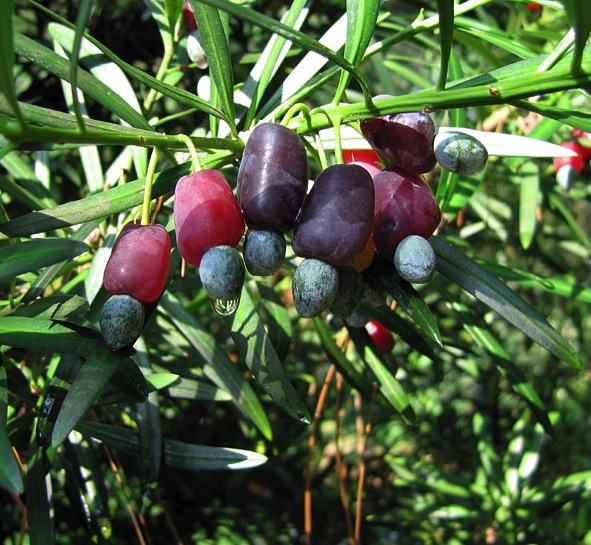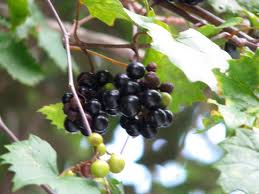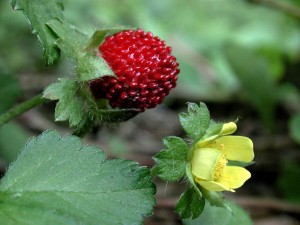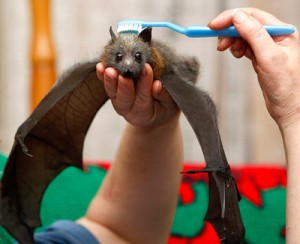Fruiting is afoot, foot fruit that is, Podocarpus macrophyllus (aka Kusamaki or Inumaki). Locally it can fruit anytime, and sporadically does. But, somewhere around August is our prime time. Add a month or more as you head north, earlier if you’re farther south.
The Podocarpus comes with a warning. The hard, bluish-green seeds are toxic. It is only the fleshy soft aril that is eaten. I have eaten many arils without any unexpected effect. Some universities say they are edible, a few say mildly toxic. I suspect if there is any toxicity related to them it is the woody core that goes through the aril. If in doubt don’t consume the woody core, and to be on the safe side children, who are a lot smaller than adults, should avoid the woody core. Again, a reminder, the seeds on the end are toxic.
The fruit can be made into pies and jelly and eaten out of hand. Botanist tell us the aril is a tasty inducement to creatures to spread the seeds around. Works for me. To read more about the Podocarpus click here.
A Site for More Ayes: If you are thinking about organizing a class in your area — read other than my regularly scheduled locations — here’s what to look for in a class site. (I will also make a post of this.) I have found large, old, city parks are usually the best locations. They have parking, drinking water and bathrooms. (The mind’s capacity is directly related to the bladder’s capacity.) It should have a proven body of water. I mean, an existing pond or lake (or shore or brackish water.) I say that because one place I was invited to had plenty of lakes on the map but none on the ground (the map they used was decades old and the water long gone.) When I arrived at another place to hold a class I asked the organizer where the body of water was, as I saw no lake or pond. He told me right below me, that he had a high water table…. The site should be a few acres or more so we can wander around different plant habitats. The addition of a field or a not-so manicured lawn is also good. Usually the less well-kept the better. State parks are usually not good locations for a wild edible plant class. There are some species there but the greater variety is found in suburbia. And the location should have an address. That’s so folks can find it. Here my near-term class schedule:
Saturday, July 28th, Spruce Creek Park, 6250 Ridgewood Ave. Port Orange, (near Daytona Beach) 32127. 9 a.m.
Sunday, July 29th, Colby-Alderman Park: 1099 Massachusetts Street, Cassadaga. FL. (near Deland) 32706., 9 a.m.
Friday, August 10th, Jervey Gantt Recreation Complex, 2390 SE 36th Ave., Ocala, FL, 34471, 9 a.m.
Saturday, August 11th, Boulware Springs Park, 7902 S. E. 15th St., Gainesville, FL, 32601. 9 a.m.
Sunday, August 12th, Florida State College, 11901 Beach Blvd., Jacksonville, FL, 32246 9 a.m.
I am still trying to firm up a teaching tour up to North Carolina and back. Looking for suitable sites in Savannah (and great one was suggested but is closed) Charleston SC, Charlotte NC, and around Boone North Carolina.

Tom Hanks when he finally makes fire in the movie Cast Away. Everyone who has made fire by friction has had that same moment.
Going to rub two sticks together and make fire? Locally willow is often used for the base. The drill can be several materials. Among those used are dog fennel and caesar weed. Sometimes the roots of those two can also be used for the base, which saves having to also find a willow tree. If I remember correctly dog fennel has a kindling temperature of 700 degrees, but you want a piece for a drill that is not hollow. One can also see why Caesar weed is a good choice. It was imported into Florida by the government to make fiber, so it has a lot of material to make dust and hence a coal. Cattail stalks also make a drill but can be flimsy. Cottonwood is also a good choice in that you can use it for the drill and the base. Not the quickest to set a coal but it usually has dry branches lying around so one does not have to go look far for materials.
Grapes are early this year. I usually start looking for ripe muscadine grapes locally in September. During a class this past weekend in Lake Alfred we saw native grapes in two areas fruiting heavily, and most of the ones I tried were sweet, unlike some years. Remember we have two basic kinds of grapes locally, the native mucadines and the escaped cultivars. The muscadines have clusters of grapes, usually four to eight, and are often acidic, and have a single tendril. The escaped cultivars have European history. They have a bunch of grapes but about half the size of commercial grapes. They are sweeter, lower in acid, and have a forked tendril. To read more about grapes go here.
It just may be that the name of anything that begins with “mock” should also not be called what ever follows “mock.” Mock Duck comes to mind. It’s tasteless gluten, not like duck no matter how imaginative one is. Mock Strawberry, aka Indian Strawberry, is another mocking munchie. It tastes like… nothing… or close to nothing and it’s in season in various parts of the country. If it is tasteless why eat it? Well, it’s not totally tasteless with just a hint of watermelon. But it does have some nutrition, and looks good in a salad. Those leaves can be added to a salad or made into tea. To learn more about the Indian Strawberry click here. To learn about true strawberries read this.
And in the category of I didn’t know that but it makes some sense bats are aural voyeurs. They listen for mating insects then swoop in for a two-for-one special while the bugs have got their … ah … guard down. In Australia mating locusts are more likely to be dinner than single locusts still looking for a good time. And German researchers, analyzing video taped movements of some 9,000 flies, found mating could increase the flies’ death rate as much as 21 percent, which brings new meaning to the phrase “dinner date.” Next question though is how do they really know this? Well… the researchers took dead, noiseless files and mounted them — so to speak — on a shed ceiling then played back sounds of mating flies versus celibate flies and watched the bats go batty… sonar sex… seems rather flighty to me… At least two trees with edible parts, baobab and kapok, are pollinated by bats.
To donate to the Green Deane Newsletter click here.







I’ve been eating “footfruit” for about a month now. I see them riding my bike and I stop for a tasty treat. The other night we went out to dinner and I told my family I’ll get the dessert outside. We picked about a dozen fruit right off thier hedges at this Sushi place. It was funny.
another neat book at the darwin parliament library:
Is that plant poisonous? An Australian field guide for livestock, pets and people. By R.C.H. Shepherd
plenty of weeds are poisonous in this book.
Green Dean, I thought for sure you’d call out horseweed as a great drill for fire starting. I haven’t tried it myself but I heard from a reliable source (you video #130) that it’s one of the best plants for for that very purpose. I love your videos, your articles and your website! Sure wish I could make it to one of your classes. If you’re ever over on the left coast, specifically California please let us know!
When are you going to write a book? I’ve got some money with your name on it when you do! =)
Great post as usual, Deane. But if I were to take your advice for the guidelines of a location for my classes, I literally would be living on the street. That’s a tall order!
A first in the seven years I have lived in Old Town, one of the many Muscadine vines on my property has gone to fruit. The fruit is plentiful and sweeter than other muscadines I have tried (although I’m certain the vine is wild- no bunches, no forked tendrils, large thick skinned fruit with large seeds). Unfortunately it is only bearing fruit up in the tree tops and the “on vine” fruit cannot be safely reached. In your experience, in a non-“survival” scenario, can the undamaged fruit be safely collected and eaten after it has fallen to the ground?
Fighting the ants for fruit is a common thing to do, such as with persimmons. As long asa they aren’t bady molded I know of no grat problem. And you might have Concord grapes…They used to grow near me in Pownal.
Dear Green,
I have found a flower I’m wondering if I can eat the roots.I was on a search to positivivley identify Jerusalem artichoke. And found this daisie like or sunflower like flower. I have seen it grow up to 6 or 7 ft.
It has multiple stems coming of a main stem. The main stem is redish in color. The roots system has multipul carrot like roots growing horizontaly. any ideas?
You can go to the Greem Deane Forum and post a picture.